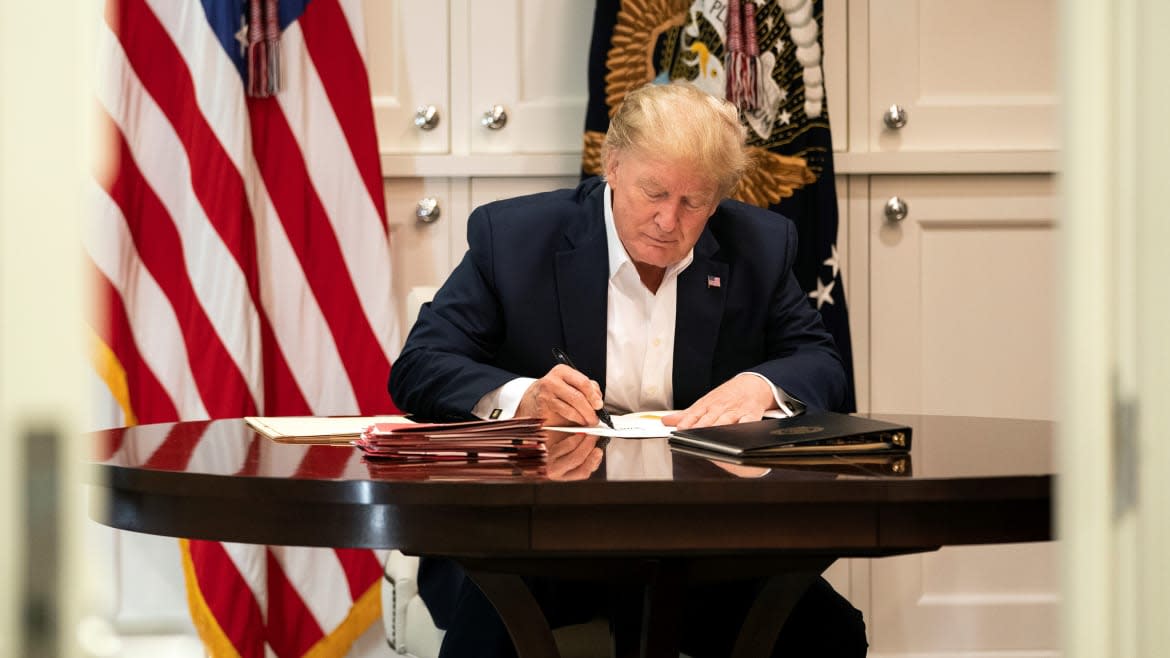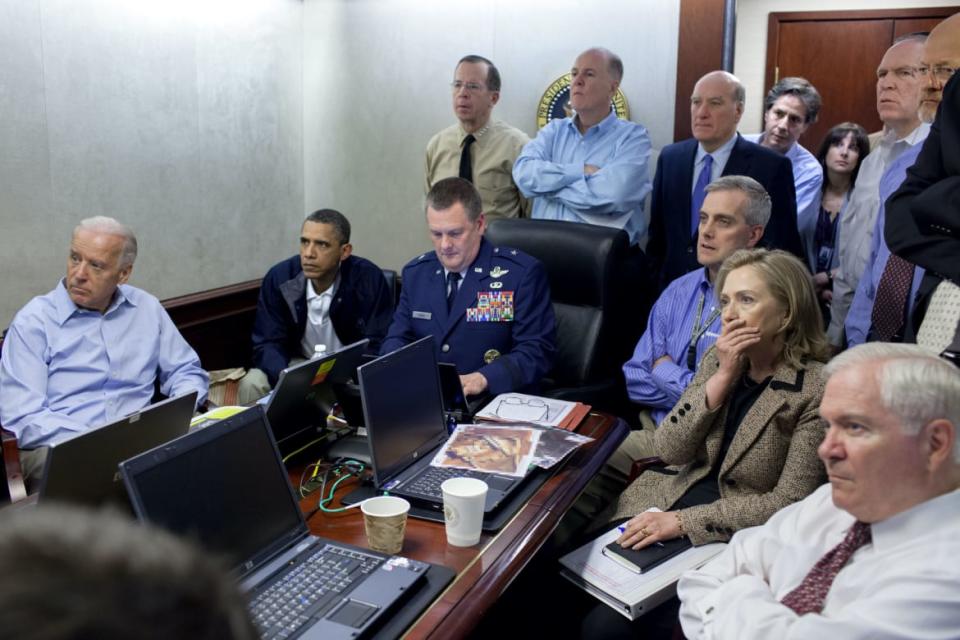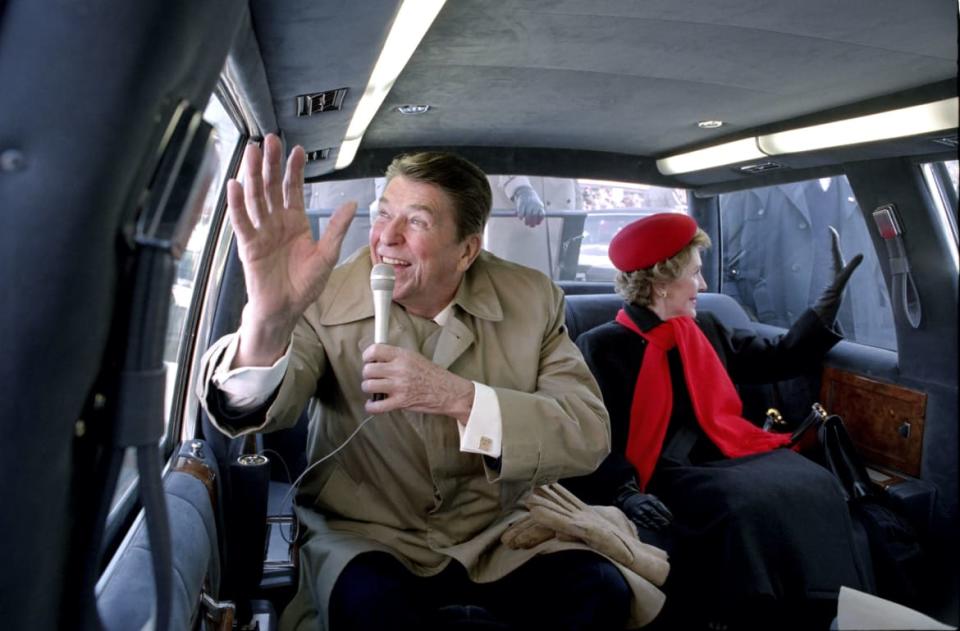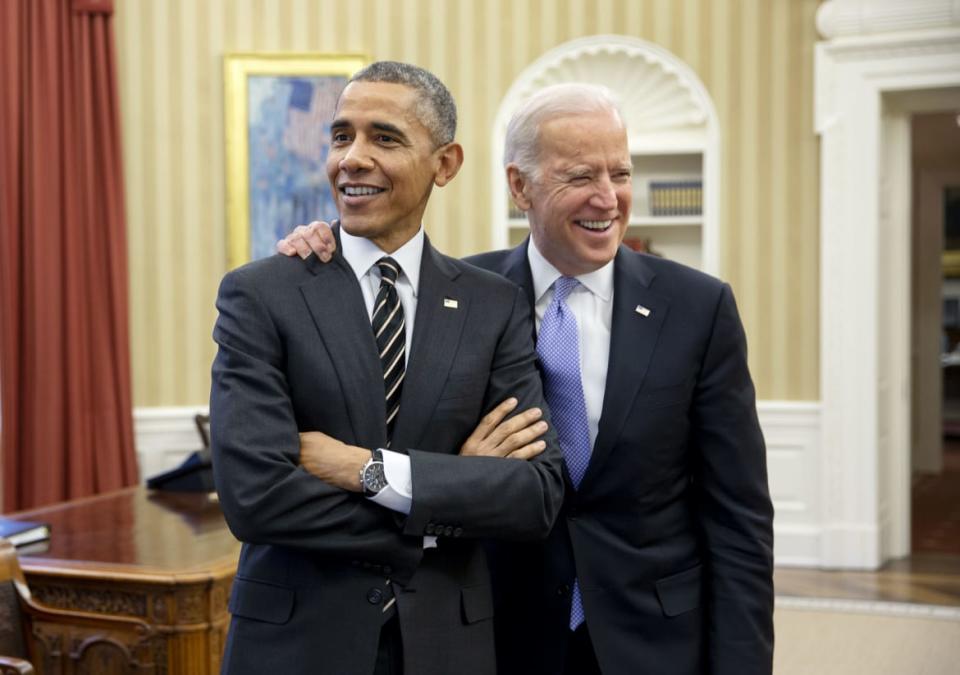Obama Photographer Pete Souza Exposes Trump’s ‘Obviously’ Staged Pics

- Oops!Something went wrong.Please try again later.
- Oops!Something went wrong.Please try again later.
As soon as Pete Souza saw the photos of President Donald Trump “working” from Walter Reed hospital earlier this month, he knew something was off.
“They were obviously posed pictures,” Souza, who worked as chief White House photographer under both President Barack Obama and President Ronald Reagan, tells me by email a couple of weeks after our longer conversation below about his new documentary The Way I See It, which will premiere commercial-free on MSNBC this Friday night at 10 p.m. ET.
Aside from the seemingly blank sheet of paper Trump can be seen signing in one of the photos, released by the White House in an attempt to prove the president was hard at work, one intrepid reporter determined that another photo, in which Trump is wearing a different outfit, was taken just 10 minutes later.
Comparing them to photos he personally took of Reagan in the hospital after he was shot by a would-be assassin in 1981, Souza says, “The pictures I made of President Reagan in the hospital were authentic and unposed, unstaged photographs.”
Asked why Americans should be outraged about all of the obfuscation by the White House over the reality of Trump’s illness, Souza replies, “I’d pose that question to any of the 215,000 families that have lost a loved one from COVID.”
The photos released by the WH tonight of the president working at Walter Reed were taken 10 minutes apart at 5:25:59 pm and 5:35:40 pm ET Saturday, according to the EXIF data embedded in both @AP wire postings that were shared by the White House this evening. pic.twitter.com/EzeqIkGdf7
— Jon Ostrower (@jonostrower) October 4, 2020
Souza, who spent much of his career as a photojournalist for the Chicago Tribune, strove for as much accuracy and transparency as possible during his time in the White House. As the man responsible for the iconic photo of President Obama, Vice President Joe Biden, Secretary of State Hillary Clinton and others watching the Osama bin Laden raid unfold in the Situation Room, he was similarly struck by a photo of Trump looking directly into the camera during the Abu Bakr al-Baghdadi raid that he now says “for sure looks posed.”
In the new documentary, Souza points out that if the president was actually “monitoring” the raid when that 2019 photo was taken, as the White House claimed, the photographer would have been blocking the screen.

President Barack Obama, Vice President Joe Biden, Secretary of State Hillary Clinton, and others in the Situation Room of the White House observing the raid against Osama bin Laden on May 1, 2011.
“I knew that to be successful I just had to have access to everything,” Souza says of the unique job of photographing the president. “And I think President Obama understood that and I made sure that I maintained that access throughout the eight years. It’s hard to speak to the access that my successor has, because I really don’t know. I mean, we don’t see hardly any behind-the-scenes photographs. But that doesn’t mean that they’re not being made.”
Though he was more or less unknown during his years in the Obama White House, Souza has developed an unlikely social media following in the time since, primarily thanks to the sly photos he began posting on his increasingly popular Instagram page in 2017 that attempted to contrast Trump and his predecessor. He ultimately compiled those juxtapositions into a 2018 book called Shade: A Tale of Two Presidents.
In this exclusive clip from The Way I See It, Souza talks about the first photo he put up of Obama sitting on the Resolute Desk with rich red curtains behind him. “I like these drapes better than the new ones. Don’t you think?” he captioned the post.
It was a subtle dig at the new gold curtains Trump had just hung in the Oval Office. “Pete is dropping shade with a comment on drapes,” one follower wrote.
“I have to admit, I had no idea what dropping shade meant,” Souza says in the film. “I knew what I was doing, I just didn’t know it was called dropping or throwing shade.”
That was Souza’s first tiptoe from behind the scenes into the spotlight. The new documentary, directed by Dawn Porter, is a giant leap.
“The world works in mysterious ways,” Souza tells me when I ask how he ended up in the film, explaining that he was initially approached by Oscar-winning actress Laura Dern and her producing partner Jayme Lemons about appearing in a documentary about his work. “There was a maybe two or three-month dance where they were trying to convince me to participate in this film,” he says. “And of course I had lots of questions because it would mean giving up whatever anonymity I had left. And I was somewhat reluctant to do that.”
But ultimately he says he felt like “this may be another way to tell the story I’ve been trying to tell in the last three-and-a-half years.”
How would you describe that story that you were trying to tell from when you started posting on Instagram?
Well, it’s trying to remind people that the presidency is a serious job. A person in that position must have character and compassion and leadership, be honest with us, believe in science, believe in facts, believe in intelligence. And I didn’t find that the current occupant had any of those qualities at all. And I thought that I wanted to, in my own unique way, having worked for both a Republican and a Democratic president, sound the alarm about what the presidency should be about. And I thought that I could offer some comparison.
Ice Cube’s Foolish, Ego-Driven Collaboration With the Trump Campaign
I want to focus on that initial decision to start posting these subtle comparisons between Obama and Trump. Can you go back to that day when you decided to start trolling Trump online, even if that’s not how you would have described it at that time?
So you have to realize there were a lot of swirling emotions for the previous two months, since the election and leading up to Inauguration Day. I figured that this guy was eventually going to cause great damage to the country, even during the transition. And I think what set me off the first day was that he sent his press secretary out to the White House podium to purposely lie about crowd size. Like, who does that? Then he goes to the CIA and in front of the wall that honors the CIA agents who were killed in the line of duty, he makes essentially a political speech about how his crowd was much bigger than Obama’s. And I’m like, this is going to go south really fast with his presidency. So it was not a difficult decision. But if you go back to the first year of me posting stuff on Instagram, my comments were somewhat subtle. And if you were not paying attention to the news, you might not know that I was throwing shade. You really had to be paying attention. And I sort of loved it when people were commenting, “What happened now? I’ve got to go Google it.” So they were paying attention to the news after seeing my post wondering what the heck had happened that day.
Was that intentional for you to make it as subtle as you could?
Yeah, I was trying to be humorous. And I think that probably lasted about a year. And then it just got to be too much. And I became even more outspoken in a more direct way.
Do you remember why you decided to post that first photo of the gold drapes in the Oval Office?
I mean, I think at the time it just fit this guy’s character to put up gold drapes. And I think the other thing too is every president has had two flags in the Oval Office. You’ve got one American flag and you’ve got one flag with the presidential seal on it. And there was a picture where it showed he had like 20 flags or something. He’s got like six American flags, six presidential seal flags, all these military flags. And I was like, what the heck is going on here?

President Barack Obama walks along the West Colonnade of the White House with Chief White House Photographer Pete Souza on Feb. 18, 2016.
You were obviously disillusioned by his first acts as president. But what was your impression of him when you were following President Obama around on Inauguration Day? What was your experience on that day from an emotional standpoint and just observing Trump entering the White House for the first time?
It was as if a mafia don had walked into the White House. He just has that presence, like he’s the head of the mafia.
What was your own personal experience on that day when Obama was leaving the White House and therefore you were leaving your job there?
The emotions were just swirling around in my head and it was kind of twofold in the sense that there was a certain amount of relief that the job was done. I worked my ass off for eight years and put a lot of time in and I was tired physically, I was tired mentally, and I was really looking forward to being done with the job, to be honest with you. But at the same time, as soon as he arrived at the White House that day for the reception before the inauguration, when Trump got out of his limousine, I kept expecting Hillary to actually pop out. Because I was still in denial about the whole thing.
One of your colleagues in the film talks about how they never really knew your personal politics during your time in the White House. I’m curious if you just weren’t sharing them or if it was something that actually developed over the time that you were in the White House with Obama? Do you feel like your personal politics changed in any way during that time?
I think my personal politics have changed throughout my life. We all grow and evolve and I think that one of the great things that I see is that so many young people are getting involved politically early on, before they’re even at voting age. I mean, you look at the kids in Parkland that started this movement because of what had happened at their school. These are kids that weren’t even eligible to vote, and yet they were out there speaking out and created this organization March for Our Lives. And I think of myself when I was 15, 16, 17, I just was not really paying that much attention. Even in my twenties, I’m somewhat embarrassed that I wasn’t more knowledgeable about what was happening in the country. So I don’t know that I changed my politics during the Obama administration, but I certainly came to really understand the importance of the presidency. And whether you agree or disagree with decisions that are made, that at least knowing that a guy is listening to all the different options and making decisions based on facts and knowledge and science, as opposed to some gut reality-show instincts, is super important.
Do you feel like Obama had a bigger influence on the way you think about politics or has Trump had a bigger influence on the way you think about politics?
That’s a really good question. I would say that Obama had a much bigger influence on how I think about politics, because a lot of decisions are very nuanced and I got to be there and witness him wrestling with these decisions and how oftentimes there’s no good option. And you’re choosing the best of the terrible options. But I think if anything, Trump has accentuated how I feel because of the disastrous way that he makes decisions and how he just sort of bullies anybody that disagrees with what he says about things.
You worked for both Ronald Reagan and Obama, who were very different in a lot of ways. But what qualities do you think they shared that Trump lacks?
Well, I think they both have a very even-tempered disposition. And I actually saw both of them get really mad, but it would take a lot to get them to that point. And I think that’s a really good attribute to have as president, being able to keep your temper in check because you’re going to be faced with a lot of really stressful, important decisions. And then I think both Reagan and Obama had empathy for other people. And I don’t think there’s an ounce of empathy in Donald Trump at all. I will also say that even though Reagan relied more on his speechwriters than Obama did—I mean, when it was a big speech, Obama essentially would write most of the speech himself—but I think both Reagan and Obama knew the power of words and knew that the words that came out of a president’s mouth were really important for the country—to our allies, to our adversaries. And I don’t think Donald Trump gets that at all.

President Reagan and Nancy Reagan in the limousine waving to the crowd in Dixon Illinois, Feb. 6, 1984.
That’s especially evidenced by the Bob Woodward revelations about what Trump was saying in private versus what he was saying in public.
Yeah, I mean, I think that Donald Trump has blood on his hands. I think he is personally responsible for the deaths of thousands of people, because he kept vital information from the American people and continues to this day to not do enough to try to get COVID under control. And I think that’s on him as a person. The fact that he knew how disastrous this could be in February and has completely downplayed it for the past six months—he should be impeached for that.
The director of the documentary Dawn Porter has said that from the beginning you told her that it was important for you that the movie came out before Election Day. Why was that so important for you?
When we go to the polls in November I wanted people to have this film as a backdrop, to learn about two previous presidents and what the job really should be about as they make a decision on who to vote for. Now, at the time I said this, which was a couple of years ago, we didn’t have COVID, we didn’t have Black Lives Matter, we didn't have disastrous forest fires. But I’ve been trying to warn for the last three-and-a-half years or longer that when you have somebody that’s in the presidency that is totally incompetent and totally dishonest that eventually it’s going to be really bad for the country. And that’s all come to a head this year as we’ve seen.
Are you hopeful about the outcome of the 2020 election?
I’m hopeful, but really nervous. Because he’s already trying to convince people that no matter what happens, that it’s a fraudulent election. And these things he’s doing with the post office and giving out misinformation about mail-in ballots and not doing anything about Russian interference, which we know is happening. So I’m nervous about it.

President Barack Obama and Vice President Joe Biden talk with senior staff following a bilateral meeting with Chancellor Angela Merkel of Germany in the Oval Office, Feb. 9, 2015.
In addition to being around Obama so much, you had an up-close-and-personal look at Joe Biden for those eight years as well. What do you think the American people should know about Joe Biden that perhaps they don’t or that doesn’t get talked about enough?
I think Joe Biden just reeks of empathy. I mean, it’s in his DNA to be empathetic about people. The way that Joe grew up in Scranton, he has that small-town thinking to every aspect of government policy. He knows how it affects people in his hometown. I think that he is also as experienced as anyone. He’s dealt with a lot of these foreign leaders themselves. And the tragedy that he’s had and his life, that has hardened him in a way, I think he’s the right man at the right time for this job.
One thing that you say toward the end of the film is that you feel like speaking out against Trump in this way means that you can’t work as a photojournalist again. That kind of surprised me. What did you mean by that?
Because I’ve been outspoken about a president, I’ve shown my opinion, I think it would be difficult for The New York Times or Time magazine or somebody like that to assign me to photograph a Trump rally, or a Biden rally for that matter. I think that I could do independent photojournalism, but I think it would be difficult to do that for a newspaper or a magazine.
Because people would assume an opinion in your photos?
Yeah, but I think it would actually be an interesting assignment, even given how I feel about Trump, for somebody to assign me to go to a Trump rally. Because I might look at things a little bit differently. I don’t know that I would accept such an assignment, because I’d be afraid that people would recognize me and that my safety might be in jeopardy.
Not to mention the COVID risk.
Yeah, the fact that he’s doing these rallies indoors is crazy. I saw an interview where he said he’s not worried about his own safety. Well, no, because you’re 50 feet away, a hundred feet away from all these other people who are all jammed together. They’re the ones that are going to get sick! And then they’re going to bring that back to their families and infect other people in the community. But it’s so typical of Donald Trump. He only thinks about himself.
Lewis Black Sounds Off on Trump, Jon Stewart, and Almost Getting Pushed Out of ‘The Daily Show’
Got a tip? Send it to The Daily Beast here
Get our top stories in your inbox every day. Sign up now!
Daily Beast Membership: Beast Inside goes deeper on the stories that matter to you. Learn more.

